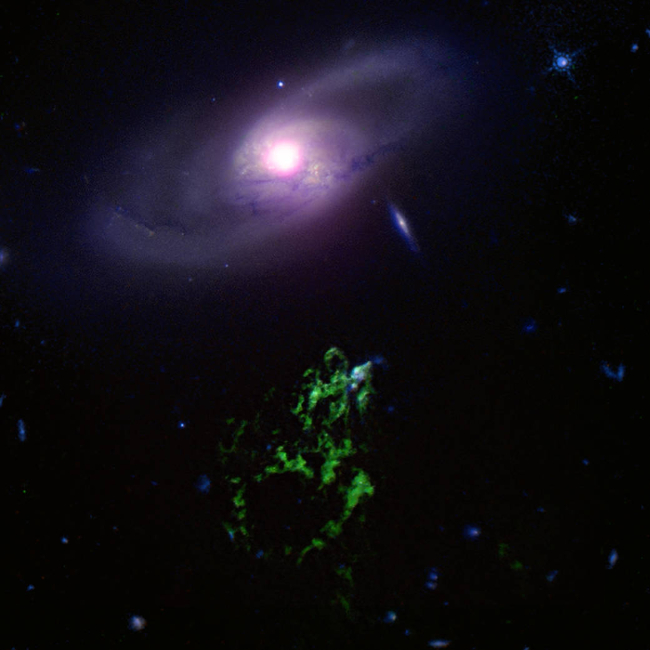
 Credit: X-ray: NASA/CXC/ETH Zurich/L. Sartori et al, Optical: NASA/STScI
Credit: X-ray: NASA/CXC/ETH Zurich/L. Sartori et al, Optical: NASA/STScI
Blob and Bubble
The excitement of science is seeing what has never been seen before, and the GalaxyZoo project has been enormously successful in bringing the excitement of scientific discovery to the general public. One of the best-known instances of this excitement was the discovery, in 2007, of a strange, glowing green cloud first seen in a GalaxyZoo image by Hanny van Arkel, at the time a Dutch schoolteacher. Professional astronomers were unsure of its origin, and so it was dubbed "Hanny's Voorwerp"; "Voorwerp" is Dutch for "object". The object is quite extended, about the size of a small galaxy, and lies very close to a spiral galaxy called IC 2497. Astronomers have shown that the "Voorwerp" glows in the green light produced by oxygen atoms excited by the strong radiation from some mysterious source. Now, new observations with the Hubble Space Telescope and the Chandra X-ray observatory have perhaps solved this mystery. The Hubble and Chandra data, shown in the composite image above (the Chandra X-ray image is shown in purple) suggest the presence of a supermassive black hole at the center of IC 2497. This black hole is currently generating X-rays, which are energetic enough to ionize the oxygen atoms in the Voorwerp. However, the Chandra data show that the observed high-energy emission from the supermassive black hole is too faint to have excited the Voorwerp. The Chandra observations also show the presence of a large bubble of cool gas embedded in the hot gas around IC 2497's supermassive black hole. This suggests that the Voorwerp was perhaps excited by a blast of radiation produced by the central black hole in IC 2497, but that this blast was only a temporary one. Instead of being a strong source of X-ray radiation, the supermassive black hole generates powerful outflows of massive particles similar to those seen in other galaxies, and that these outflows created the cool bubbles in the hot gas seen by Chandra. The Voorwerp thus may be the X-ray "echo" of a time when the supermassive black hole was much brighter, helping to reveal the feeding habits of the central black hole of IC 2497.
Published: August 22, 2016
<
HEA Dictionary ● Archive
● Search HEAPOW
● Other Languages
● HEAPOW on Facebook
● Download all Images
● Education ● HEAD
>

Each week the HEASARC
brings you new, exciting and beautiful images from X-ray and Gamma ray
astronomy. Check back each week and be sure to check out the HEAPOW archive!
Page Author: Dr. Michael F. Corcoran
Last modified Monday, 26-Feb-2024 17:47:37 EST


